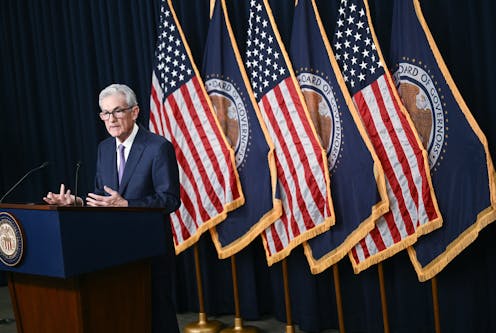Inflation is cooling, but not fast enough for the Fed: Policymakers now expect only one rate cut in
The Federal Reserve is being characteristically cautious.

It was a double-whammy Wednesday for economic-data enthusiasts.
During the morning of June 12, 2024, the Bureau of Labor Statistics published its latest inflation figures. The news was relatively good, showing that inflation rose 3.3% in the year to May 2024 – less than some analysts had expected.
A few hours later, the Federal Reserve concluded its June meeting by holding interest rates steady – as forecasters expected – and releasing an updated set of economic projections.
What does it all mean? The Conversation U.S asked economist Christopher Decker to explain.
What are your major takeaways from the latest inflation report?
The May inflation rate – as measured by the Consumer Price Index for All Urban Consumers, or CPI-U – was down a bit from April, but not by much. Basically, this implies that not much changed on the inflation front, and it’s been like this for a while now.
This isn’t a bad thing, though. I like to take the long view: U.S. inflation has really stabilized around 3.3%. In fact, we’ve been around 3% to 3.7% for 12 months now. So we have stable price growth – even if it’s higher than the Fed’s target rate of 2% – as well as wage and job growth. This economy is still quite strong.
In terms of the details, energy prices are down compared with last month – but energy prices tend to be volatile, so that might be a blip in the data, not a real trend. Labor markets are still tight. Average hourly earnings rose 4.1% this May compared to last year, indicating that employers need to pay higher wages to attract new workers and retain existing ones.
In May, inflation-adjusted earnings increased 0.5% from April to May of this year. So with wages outpacing inflation, consumer spending – which amounts to two-thirds of American gross domestic product – will likely increase. Payrolls increased by 272,000 in May, up from 165,000 and 310,000 in April and March, respectively.
In short, this report, along with other recent data reports, continues to show a fairly robust and stable economy.
Why has inflation stayed above the Federal Reserve’s 2% target for so long?
Housing and rents are major reasons inflation has stayed above 2%. Rental prices are up due to higher construction and maintenance costs, as well as strong demand from people priced out of homeownership. Home prices and mortgage rates remain high, making home purchases difficult, particularly for first-time homebuyers.
The Fed held interest rates steady today, and indicated it would likely cut rates one time in 2024. But just three months ago, policymakers were mulling three rate cuts this year. What changed?
The Fed is very data-driven, and when the data changes, the Fed changes course.
It’s important to remember that the Fed has hiked rates more than 10 times since March 2022. This was done in an effort to slow economic growth and thereby rein in inflation. I think a lot of policymakers thought that would push the inflation rate down more rapidly than it did. Instead, job growth remained stronger than expected.
In many ways, the labor market is still working through COVID-related disruptions. Many workers gradually reentered the workforce. Therefore, production could increase to meet demand for goods and services. This meant that there was room for the economy to grow even with slightly higher inflation.
The U.S. also saw supply-chain disruptions unlike anything in recent memory. We’re likely still dealing with a few residual effects here, as well. As a result, higher rates worked to slow inflation down – just not to 2%.
Now, time will tell if we are at a new normal. The Fed clearly doesn’t think so. It’s still holding fast to 2% inflation. If the labor market does seem to settle where it currently is, then we may see some elevated wage increases compared to pre-COVID rates. That could lead to slightly higher inflation rates, as firms seek to keep profit margins while covering higher labor costs.
If inflation is stable and wages have been showing some growth, why do so many Americans feel bad about the economy?
I think part of it is that people tend to compare today’s prices to prices they paid years ago – they’re not focusing so much on month-to-month inflation. For example, the average price of a dozen eggs is about $US2.70 today, whereas before COVID it was $1.46 or so. People remember that and feel ripped off – forgetting that eggs were $4.82 in early 2023 and those prices have generally fallen since.
What do you think will happen the rest of this year?
Even if we set aside the Fed’s 2% inflation target, from a macroeconomic perspective the data right now simply doesn’t suggest we need to change interest rates. Economic growth isn’t slowing dramatically, so cutting rates isn’t necessary. And inflation isn’t accelerating, so increasing rates isn’t justified.
Holding rates constant – as hard as that is for some potential homebuyers to hear – is just the most sound policy right now.
What do you think will happen in the long term?
I was looking at the Fed’s most recent “dot plot,” which shows where each of the Fed’s voting officers expect benchmark interest rates will settle in 2024, 2025 and 2026.
The majority of officials think the federal funds rate, currently at 5.3%, will stay at about this level for the rest of this year, then fall to a bit above 4% in 2025. Most then think it will reach 3.25% or so by 2026. So they are betting on the need for rate cuts in 2025 and 2026.
This makes sense to me – certainly for 2025. There are signs of a slowing economy and slowing job market. Expect any moves toward rate cuts to be gradual, though. The Fed is being very cautious, and so long as there are no dramatic spikes in the key job and inflation data, a gradual lowering is a fair bet.
Christopher Decker does not work for, consult, own shares in or receive funding from any company or organization that would benefit from this article, and has disclosed no relevant affiliations beyond their academic appointment.
Read These Next
Data centers need electricity fast, but utilities need years to build power plants – who should pay?
How many data centers will be built – and how much electricity they’ll need – is uncertain. Being…
Donor-advised funds have more money than ever – and direct more of it to politically active charitie
When foundations make grants to DAFs, the digital trail normally created instead becomes a dead end.
How I rehumanize the college classroom for the AI-augmented age
A writer instructor recognizes the role of AI on campus, while elevating social connection and humanity…






